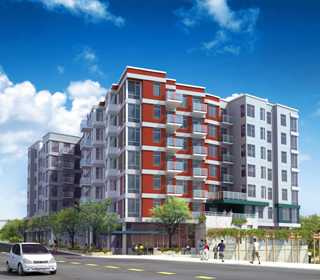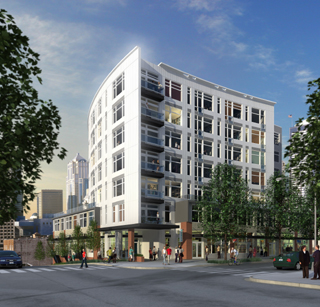
DJC.COM
May 29, 2008
Seattle needs more work to reach its urban potential
Harbor Properties

Onslow
|

Barkman
|
Developers have been successful due to a broad commitment to creating buildings offering economic growth through ground-floor commercial tenants and an influx of new, employable residents, as well as urban lifestyle opportunities to everyone who wants to live closer to work. They’ve also been aided by their ongoing collaboration with local government officials who seek to make Seattle — and its many distinct neighborhoods — a shining national example of smart, strategic urban growth.
Despite these positive steps, there’s much more work to be done to help Seattle reach its immense urban potential over the next decade and beyond. Developers must continue to think more creatively about the kinds of projects that work best for neighborhoods with long-standing histories and unique urban characteristics needing to be preserved. It’s equally important for city officials to remain flexible in their efforts to balance incentive-based development initiatives and the natural economic forces that drive the real estate industry.
Affordability gap

Images courtesy of Harbor Properties
Harbor Properties earlier this year started construction on the Mural Apartments in West Seattle. The 136-unit project will have three shared Zipcars for residents.
|
The city’s Multi-Family Tax Exemption program is a viable tool for enhancing livability and providing financial-based incentives for developers to build additional in-city housing for the area’s workforce population, as well as individuals making somewhat less than Seattle’s median income.
Increasing the city’s urban housing supply will be important over the next several decades. A recent study by the Puget Sound Regional Council indicates that by 2040 the Central Puget Sound region will need to accommodate an additional 1.7 million residents and another 1.2 million jobs.
But these government-led initiatives alone won’t completely bridge the gross disparity that exists between the cost of Seattle’s urban housing and the average annual income of the in-city workforce. Organizations such as the Urban Land Institute and former Seattle mayor Charles Royer’s Middle Income Housing Alliance are actively seeking solutions to this problem. Developers need other tools to help make their mixed-use, moderately priced projects financially feasible within the high-cost urban-development landscape.
One idea would be for the city to implement a reduction in parking-ratio code requirements, especially in urban villages where Metro buses and expanded transit services make it easier for residents to commute without a car. Viable alternatives to daily car commuting are a significant part of the overall solution to increasing urban densities in a sustainable way. In West Seattle, where King County’s Metro RapidRide will begin service in 2011, residents will be able to get downtown more conveniently while they minimize their impact on the environment.
Alternative transportation

When finished this fall, Landes will have 81 market-rate apartments, including three live/work units, in Seattle’s First Hill neighborhood. |
As long as residents have the ability to get to work on foot, bike, streetcar, light rail, bus or other means of public transportation, their dependence on car ownership will be diminished. Better yet, some of the money they once spent on car payments, insurance, maintenance and parking can be reallocated to other, more-sustainable resources — including in-city housing, Zipcar services, bus passes and other environmentally friendly means of transportation. And by spending less time in traffic, residents can increase their career productivity, reduce their carbon footprint, or simply take more time to enjoy the benefits of an urban lifestyle.
Realizing these objectives, however, is a two-way street. Developers must continue to work with local governments to determine future routes and the right modes of transportation and station locations for each of Seattle’s urban communities. In addition, the private and public sectors need to collaborate on expanding walking and biking routes and conveniences and amenities that surround these urban transportation nodes. These energies will be critical in helping to align densities and ridership in a way that maximizes the communities’ financial commitments.
Sustainable strategies
The city has identified several communities that are most suitable for growth and can be further “compacted” through zoning that allows for mid-rise, mixed-use residential development. In order to bring these types of projects to market, though, permitting processes need to be more efficient and focused on the specific housing features the city wants created.
Inner-city departments, utility-company requirements and restrictive building codes can add prohibitive time- and financial-based costs to the development process, as well as restrict the ultimate use of the property. Developers, like the city, want to deliver the type of multifamily housing that residents demand. Simplifying the entitlement process will enhance everyone’s ability to achieve these goals.
That said, developers need to do a better job at communicating with Seattle’s government leaders about the types of project elements that constitute sustainable design and development. A project that doesn’t achieve LEED or Built Green status doesn’t necessarily mean that it’s not highly sustainable. In fact, densification of urban environments through the development of mixed-use, multifamily projects is eco-friendly by its very nature, especially when those developments are located close to public-transportation nodes.
One sustainable strategy is partnering with existing community resources to avoid duplication of product or services within developers’ mixed-use projects. For instance, Harbor Properties recently aligned with the University District YMCA to provide residents of its two recently developed projects, located a block away, with free memberships to the Y’s fitness center and community programs. Harbor is expanding this relationship in West Seattle where it’s exploring with the YMCA the idea of taking some space in some of Harbor’s planned developments. The satellite “campus” would potentially be used for a wide range of health and fitness programs.
Some developers are partnering with Zipcar and similar services to give residents exclusive access to on-site, eco-friendly cars at a subsidized rate. The idea is to encourage just-in-time car transportation and diminish the need for creating expensive (and often unused) subterranean parking spaces at the building.
Involving the community
To increase the feasibility of dense, in-city projects, developers also need to be more proactive in working directly with community stakeholders, which often include neighborhood business leaders, citizen activist groups, existing residents and neighborhood associations such as the chamber of commerce. More often than not, local stakeholders who have a much longer history in the neighborhood than the developer can provide invaluable information about what kind of apartment features will be in the greatest demand by future residents.
Sometimes, these collaborations simply present an opportunity to improve the public space that already surrounds the future residential project. For example, several years ago when Harbor was developing the Alcyone project, it partnered with Vulcan Inc., Pemco, the city and Cascade neighborhood leaders to renovate Cascade Park and Playground. The public-private effort completely transformed a once-underused public space into a safe haven for families, local residents and workers.
Lastly, developers and government leaders alike should give greater consideration to creative commercial solutions to ground-floor mixed-use space in Seattle’s urban neighborhoods. The more traditional approach to filling that valuable space is with coffee shops, eateries, apparel stores and other commercial entities. But sometimes the answer might be a school, a residential live-work tenant or a professional-services firm, even if the area isn’t zoned for that type of tenant. The idea is to remain flexible and open minded on which commercial use will ultimately provide the most vibrancy to the community, even if it’s an interim use, and give these dense, urban mixed-use neighborhoods the best chance for success.
Denny Onslow is executive vice president and chief development officer and Martha Barkman is a senior project manager at Harbor Properties, a Seattle-based real estate company. Harbor develops and owns downtown real estate and partners on multiple residential and commercial projects in and surrounding the urban core. Harbor is planning several mixed-use urban villages in Seattle’s neighborhoods.
Other Stories:
- Is your building in it for the long run?
- Community-engaging design activates civic spaces
- How stewardship benefits Seattle’s streets
- Condo owners are seeing green
- Keeping infill projects predictable and on schedule
- Downtown condo pipeline favors sellers
- A new urban neighborhood to spring forth in Bellevue
- Tech campuses follow the San Jose model
- Sustainability starts with historic preservation
Copyright ©2009 Seattle Daily Journal and DJC.COM.
Comments? Questions? Contact us.